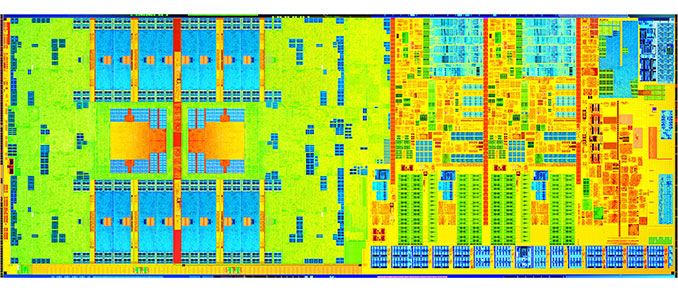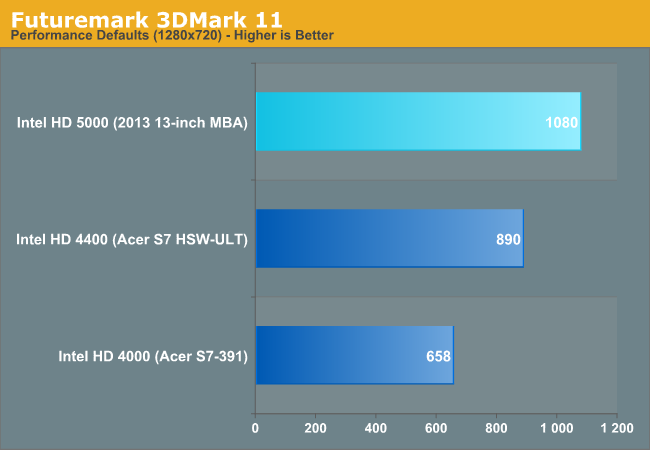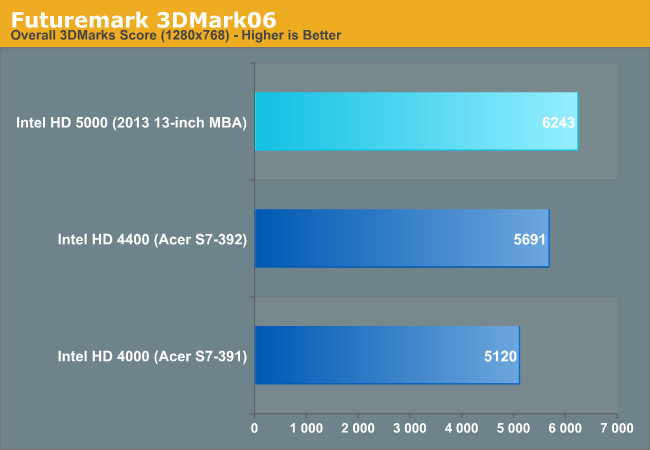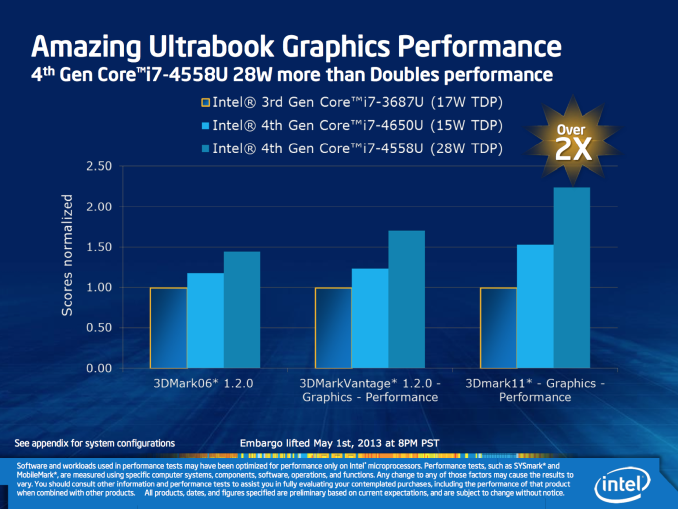A Look at Intel HD 5000 GPU Performance Compared to HD 4000
by Anand Lal Shimpi on June 24, 2013 6:02 PM EST
When I got my hands on a Haswell based Ultrabook, Acer's recently announced S7, I was somewhat disappointed to learn that Acer had chosen to integrate Intel's HD 4400 (Haswell GT2) instead of the full blown HD 5000 (Haswell GT3) option. I published some performance data comparing HD 4400 to the previous generation HD 4000 (Ivy Bridge GT2) but added that at some point I'd like to take a look at HD 5000 to see how much more performance that gets you. It turns out that all of Apple's 2013 MacBook Air lineup features Haswell GT3 (via the standard Core i5-4250U or the optional Core i7-4650U). Earlier today I published our review of the 2013 MBA, but for those not interested in the MBA but curious about how Haswell GT3 stacks up in a very thermally limited configuration I thought I'd do a separate post breaking out the findings.
In mobile, Haswell is presently available in five different graphics configurations:
| Intel 4th Generation Core (Haswell) Mobile GPU Configurations | ||||||||
| Intel Iris Pro 5200 | Intel Iris 5100 | Intel HD 5000 | Intel HD 4400 | Intel HD 4200 | ||||
| Codename | GT3e | GT3 | GT3 | GT2 | GT2 | |||
| EUs | 40 | 40 | 40 | 20 | 20 | |||
| Max Frequency | 1.3GHz | 1.2GHz | 1.1GHz | 1.1GHz | 850MHz | |||
| eDRAM | 128MB | - | - | - | - | |||
| TDP | 47W/55W | 28W | 15W | 15W | 15W | |||
The top three configurations use a GPU with 40 EUs, while the HD 4400/4200 features half that. Intel will eventually introduce Haswell SKUs with vanilla Intel HD Graphics, which will only feature 10 EUs. We know how the Iris Pro 5200 performs, but that's with a bunch of eDRAM and a very high TDP. Iris 5100 is likely going to be used in Apple's 13-inch MacBook Pro with Retina Display as well as ASUS' Zenbook Infinity, neither of which are out yet. The third GT3 configuration operates under less than a third of the TDP of Iris Pro 5200. With such low thermal limits, just how fast can this GPU actually be?
First, let's look at what Intel told us earlier this year:
Compared to Intel's HD 4000 (Ivy Bridge/dark blue bar), Intel claimed roughly a 25% increase in performance with HD 5000 in 3DMark06 and a 50% increase in performance in 3DMark11. We now have the systems to validate Intel's claims, so how did they do?


In 3DMark 11 we're showing a 64% increase in performance if we compare Intel's HD 5000 (15W) to Intel's HD 4000 (17W). The 3DMark06 comparison yields a 21% increase in performance compared to Ivy Bridge ULV. In both cases we've basically validated Intel's claims. But neither of these benchmarks tell us much about actual 3D gaming performance. In our 2013 MBA review we ran a total of eight 3D games. I've summarized the performance advantages in the table below:
| Intel HD 5000 (Haswell ULT GT3) vs. Intel HD 4000 (Ivy Bridge ULV GT2) | |||||||||||
| GRID 2 | Super Street Fighter IV: AE | Minecraft | Borderlands 2 | Tomb Raider (2013) | Sleeping Dogs | Metro: LL | BioShock 2 | ||||
| HD 5000 Advantage | 16.2% | 12.4% | 16.9% | 3.0% | 40.8% | 6.5% | 2.3% | 24.4% | |||
The data ranges from a meager 2.3% advantage over Ivy Bridge ULV to as much as 40.8%. On average, Intel's HD 5000 offered a 15.3% performance advantage over Intel's HD 4000 graphics. Whether or not that's impressive really depends on your perspective. Given the sheer increase in transistor count, a 15% gain on average seems a bit underwhelming. To understand why, you have to keep in mind that the performance gains come on the same 22nm node, with a lower overall TDP. Haswell ULT GT3 has to be faster, with less thermal headroom than Ivy Bridge ULV GT2.
The range of performance improvement really depends on turbo residency. With only a 15W TDP (inclusive of the CPU and PCH), games that have more CPU activity or the right combination of GPU activity will see lower GPU clocks. In Borderlands 2 for example, I confirmed that the GT3 GPU alone was using up all of the package TDP thus forcing lower clocks:

All of this just brings us to the conclusion that increasing processor graphics performance in thermally limited conditions is very tough, particularly without a process shrink. The fact that Intel even spent as many transistors as it did just to improve GPU performance tells us a lot about Intel's thinking these days. Given how thermally limited Haswell GT3 is at 15W, it seems like Broadwell can't come soon enough for another set of big gains in GPU performance.
I also put together a little graph showing the progression of low TDP Intel GPU performance since Sandy Bridge. I used GRID 2 as it seemed to scale the most reasonably across all GPUs:
Note how the single largest gain happens with the move from 32nm to 22nm (there was also a big architectural improvement with HD 4000 so it's not all process). There's definite tapering that happens as the last three GPUs are on 22nm. The move to 14nm should help the performance curve keep its enthusiasm.
If you want more details and Intel HD 5000 numbers feel free to check out the GPU sections of our 2013 MacBook Air review.












55 Comments
View All Comments
Namisecond - Monday, August 19, 2013 - link
I think we have reached that baseline of UI acceleration. Intel's baseline integrated graphics is now the HD. It suffices for everything aside from gaming. I'm using it in a celeron 847 windows box connected to my 1080p TV. CPU usage can be a bit high when streaming HD content from services like netflix, but I very rarely see a skipped frame, and with an SSD, performance is snappy.name99 - Tuesday, June 25, 2013 - link
"increasing processor graphics performance in thermally limited conditions is very tough, particularly without a process shrink. The fact that Intel even spent as many transistors as it did just to improve GPU performance tells us a lot about Intel's thinking these days. "As always on the internet, the game fanatics completely miss the point when they think this is all about them. Intel doesn't give a damn about game players (except to the extent that it can sell them insanely overpriced K-series devices which they will then destroy in overclocking experiments --- a great business model, but with a very small pool of suckers who are buying).
What Intel cares about is following Apple's lead. (Not just because it sells a lot of chips to Apple but because Apple has established over the past few years that it has a better overall view of where computing is going than anyone else, or to put it differently, where it goes everyone else will follow a year or two later.)
So what does Apple want? It's been pretty obvious, since at least the first iPhone, how Apple sees the future --- it was obvious in the way the iPhone compositing system works with as basic elements the "layer" (ie a piece of backing store representing a view, some *fragment* of a window) rather than with a window as the basic unit. The whole point of layers is that they allow us to move the graphics heavy lifting from JUST compositing (ie CPU creates each window, which GPU then composites together) to all drawing.
We've seen this grow over the years. Apple has moved more and more of OSX (subject to the usual backward compatibility constraints and slowdowns) to the same layering model, for example they've given us a new scrolling model for 10.9 which allows for smooth ("as butter????") scrolling which is not constrained by the CPU.
So step 1 was move as much of the basic graphics (blitting, compositing, scaling) to the GPU.
But there is a step 2, which became obvious a year or so later, namely moving as much computation as makes sense to the GPU, namely OpenCL. Apple has pushed OpenCL more and more over the years, and they're not just talking the talk. Again part of what happens in 10.9 is that large parts of CIFilter (Apple's generic image manipulation toolbox, very cleverly engineered) moves to run on the GPU rather than the CPU. Likewise Apple is building more "game physics" into both the OS (with UI elements that behave more like real world matter) and as optimized routines available for Game Developers (and presumably ingenious developers who are not developing games, but who can see a way in which things like collision detection could improve their UIs). I assume most of these physics engines are running on the GPU.
Point is --- the Haswell GPU may well not be twice as large in order to run GRAPHICS better, it's twice as large in order to be a substantially better OpenCL target. Along the same lines, it's possible that the A7 will come with a GPU which does not seem like a massive improvement over its predecessor and the competition insofar as traditional graphics tasks goes, but is again a substantially better OpenCL target.
(I also suspect that, if they haven't done so already, it will contain a HW cell dedicated to conversion to or from RGB to sRGB and/or ICC. Apple seems to be pushing really hard for people to perform their image manipulation in one of these two spaces, so that linear operations have linear effects. This is the kind of subtle thing that Apple tends to do, which won't have an obviously dramatic effect, not enough to be a headline feature of future HW or SW, but will, in the background, make all manipulated imagery on Apple devices just look that much better going forward. And once they have a dedicated HW cell doing the work, they can do this everywhere, without much concern for the time or energy costs.
tipoo - Tuesday, June 25, 2013 - link
I'm not sure I follow. GT3 ULV is twice as big so that it can be clocked lower, the two cancel parts of each other out. The OpenCL performance, then, won't increase any more than game performance, as far as I can see.name99 - Tuesday, June 25, 2013 - link
A better OpenCL target doesn't just mean faster. It means better handling of conditionals for example. And there are plenty of things in OpenCL 1.2 which could be done inefficiently with older HW, but much more efficiently with appropriately targeted hardware.This is my point. Anand et al are assuming all that extra HW exists purely to speed up OpenGL, and that it does basically a lousy job of it. I'm suggesting that most of the HW is there to speed up OpenCL, and it won't appear in benchmarks which don't test OpenCL appropriately.
tipoo - Wednesday, June 26, 2013 - link
I see. I've suspected that was the route Apple was taking years ago, but so far the GPU acceleration is nothing exotic, but perhaps they've been laying a multi year foundation for some big upgrade, we never know. I think they broke the chain of OpenCL compatible GPUs one time though, going from the 320m to HD3000 if I'm not mistaken. It would be a bummer if the newer 3000 Macbooks couldn't get the upgrade while the older 320m ones were fine.tipoo - Wednesday, June 26, 2013 - link
By the way, regarding the A7 comment, if it really does use the SGX 600 series/Rogue, that would also be a huge gaming boost. It supposedly hits 200Gflops, into the PS360 range.ananduser - Tuesday, June 25, 2013 - link
Thank you for enlightening us on Apple's strategy and why we should all follow it as it is perfect no matter what.name99 - Tuesday, June 25, 2013 - link
Really? That's what I was doing? I thought I was explaining why a doubling in the area of the GPU didn't appear to result in a commensurate improvement in OpenGL performance; along with some business background as to WHY Intel is ramping up the OpenCL rather than the OpenGL performance.If you have an alternative explanation for the performance characteristics we're seeing, I think we'd all like to hear it.
ekotan - Friday, June 28, 2013 - link
Well, I believe name99 makes some great points. OpenCL is gaining traction not just because it accelerates massively-parallel exotic scientific algorithms which the general user would never use, but also because Apple is leveraging it to accelerate everyday operations of the OS which the general user would use constantly.Sales data shows that people are opting to purchase more and more mobile devices, and they want better battery life and decent performance. A discrete GPU, although powerful, cannot deliver the "better battery life" part of that equation, so Intel has a big win if they can improve their IGP to the point where it can deliver, say, 80% of the performance of a mid-range discrete GPU at 20% of the power cost. That makes sense to me.
Gamers will still only be satisfied with their desktop machines and discrete GPUs, no change there, but that is not the target Intel is intending to go after with their IGP efforts.
knicholas - Friday, July 12, 2013 - link
So if I do not game and mainly use laptop for editing RAW pics and watching 1080p videos, is the hd5000 overkill? other uses is web browsing ADD (i usually have about 10 tabs open. 5 articles and 5 loading youtube). im asking b/c im considering the vaio duo 13 but not sure if the hd5000 is better for my needs or not.